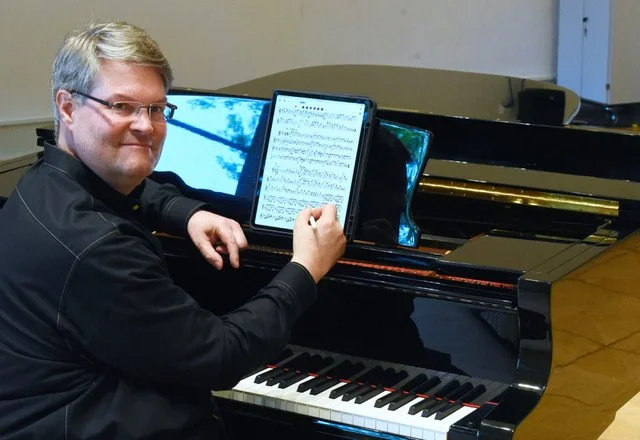All about the metronome
All about the metronome
Does the "tick-tock, tick-tock" of the hands giving the tempo in a small box ring a bell? This regular rythm comes from an instrument called a metronome. Designed to help maintain a steady tempo, the metronome is a must-have instrument for many musicians and music teachers.
A simple, effective tool, the metronome enhances the rhythmic precision of playing, while ensuring a coherent interpretation of a musical work. Its tempo indicator provides a sound guide that helps musicians develop consistency in their playing, essential for amateurs and professionals alike. Whether for piano, violin, guitar or any other instrument, the metronome is an invaluable accessory for learning and mastering music. Here, Newzik looks back at the origins, composition and functions of the metronome, an instrument that has revolutionized music!
What is a metronome?
The metronome was originally invented in the early 19th century by Dietrich Nikolaus Winkel, and later improved by German engineer Johann Maëlzel. In the 1770s, the young Johann Maëlzel took up music and became a pianist at the age of 14. The inquisitive musician wanted to go further and understand the mechanics of musical instruments. He met watchmakers who specialized in making musical clocks. Maëlzel went on to make friends with an illustrious German composer, Ludwig Van Beethoven.
At the end of the 18th century, Johann Maëlzel began manufacturing automata and mechanical musical instruments. At the time, only the chronometer created by Etienne Loulié was used by musicians as a time indicator. Maëlzel found this chronometer cumbersome and not very advanced. In Holland, he entrusted mechanic Dietrich Nikolaus Winkel with the task of devising a new system, which would later become known as the metronome system. Back in Vienna, Maëlzel applied what he had learned to create the metronome. The instrument officially revolutionized the world of music in 1815.
For over 200 years, the invention of the metronome has provided musicians with a reliable tool for working on tempo and rhythmic precision.
💡 A necdote: To thank his friend and inventor of the metronome, Beethoven even composed a canon in honor of the instrument. The tempo of the notes in this canon named Ta ta ta lieber Maëlzel actually imitates the regular rythm of the metronome.
What is the metronome, the tempo indicator, made of?
The composition of a traditional metronome
Technically, the mechanical metronome consists of :
A case, usually made of wood or plastic. The metronome case protects the internal mechanisms. Depending on the model, the case can be pyramidal, rectangular or decorated.
An oscillating **** balance wheel in the form of a metal **** stem with an adjustable weight. The pendulum swings from left to right to create rhythmic movement. The weight can be moved along the rod to modify the tempo.
A tempo dial, a numbered scale engraved on the balance stem or case. It indicates beats per minute (BPM). By moving the weight along the stem, you can set the desired tempo.
A spring mechanism is ****the heart of the mechanical metronome. This mechanism works in a similar way to a spring-loaded clock. It is activated by a winding key, and the spring progressively relaxes, driving the pendulum in an oscillating movement.
An escapement system that regulates the movement of the balance wheel. This system ensures that the balance oscillates at a constant rythm , corresponding to a set tempo.
A winding key to wind up the metronome spring. This key is usually located on the side or rear of the case.
The composition of a metronome varies according to the variety of the traditional or digital model.
The metronome in the form of a digital box or mobile application
While the main function of the metronome remains the same regardless of its shape and material, there are three main types of metronomes:
The mechanical metronome works with a spring mechanism and a classic oscillating pendulum, as described above.
The electronic metronome offers digital settings and often additional features such as various sounds and lights. Today, some modern models are electronic, incorporating digital displays and precise setting options. One box contains an adjustable electronic system with buttons for selecting tempo, rhythm signature, volume and other options. These settings can include "+" and "-" buttons, different modes, and sometimes a "Tap" button for setting the tempo by tapping the desired rythm .
The metronome functions integrated into certain mobile applications or software programs mean you don't have to bother with a metronome box.
Modern versions of the metronome offer more functionality and flexibility, making it an even more valuable tool for learning and practicing music.
👍 The practical tip: don't have room to carry your metronome case with you to music lessons or rehearsals? The Newzik application has an integrated integrated metronome function ! This in-app metronome function lets you easily set up the desired rhythm and adjust its parameters.
What's a metronome for?
Whether mechanical or electronic, the metronome is designed to provide a steady pulse that helps musicians maintain a constant tempo when playing their instrument.
The metronome helps musicians in many ways, from learning musical rhythms to mastering the tempo of a piece. In a band or orchestra, ensuring that all musicians are tuned to the same rhythm is essential. Whether you play guitar, piano or violin, a metronome also helps you maintain a constant tempo and improve the rhythmic accuracy of your playing. With regular practice, you'll improve the rhythm of your playing.
Using a metronome is also effective for working through difficult passages in a composition. In fact, adjusting the metronome to a slower rythm allows you to work on more complex parts of a piece progressively. Once a piece of music has been mastered at a slow tempo, the metronome speed can be increased to practice playing the piece at a higher tempo.
💡Using the metronome can also be a great help in learning to master the repetition of an ostinato to perfection!
How to use a metronome
The use of a metronome varies according to the musician's needs, but it is possible to follow a few tips to get to grips with the functions of a tempo indicator:
Start by setting the tempo, choosing a metronome pulse suited to your level and the piece you're playing. The pulsation corresponds to the "tic" or "beep" sound you hear with the metronome. If you set your metronome to a speed of 60, this corresponds to 60 beats per minute (1 beat = 1 second). If you switch to a speed of 80, you'll have 80 beats per minute, and so on.
You can then set the tempo of whatever you're playing to a different number of beats per minute to practice playing different tempos. Start at a slower tempo to master complex passages, then gradually increase.
Use the metronome's functions to accentuate a bar or certain beats and learn to practice a variety of rhythmic signatures.
Tempo indications (Italian terms) :
| Name |
Indication of rythm |
Pulses per minute |
|---|---|---|
|
Grave |
very slow |
below 40 |
| Largo / Larghetto | large | 40-60 |
| Lento / Adagio | slow, comfortable | 60-80 |
| Andante / Andantino | going | 80-108 |
| Moderato | moderately | 108-120 |
| Allegro | fast | 120-168 |
| Presto | very fast | 168-200 |
| Prestissimo | extremely fast | 200-208 |
🛕 How to use the "metronome" function on the Newzik application?
Click the button next to the metronome icon in the bottom right-hand corner of the screen to switch on the metronome.
Click on the metronome to modify its parameters:
→ Modify the tempo using the slider, the - and + buttons or the "Tap" button.
→ Change the metronome sound.
→ Modify the rhythm signature.
→ Switch from a sound metronome to a visual metronome, or combine the two.
Need to add a countdown timer while recording a score? Use the features of Newzik Web to adjust tempo settings or launch a metronome. It's easy: while recording, click on the metronome icon next to the "Record" tab and off you go!






